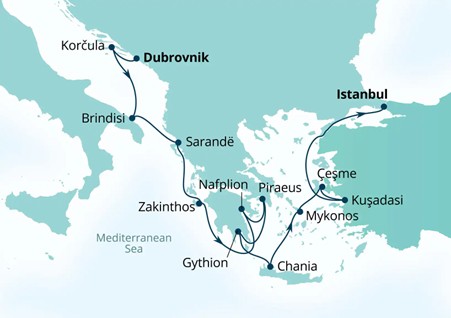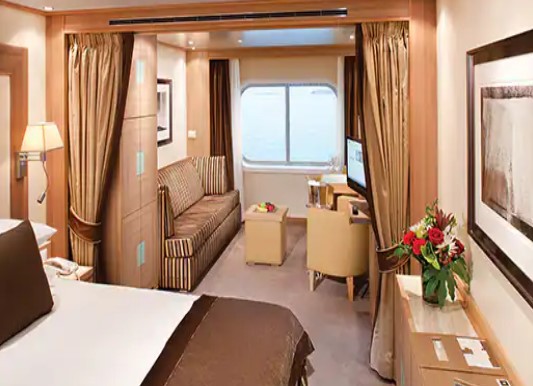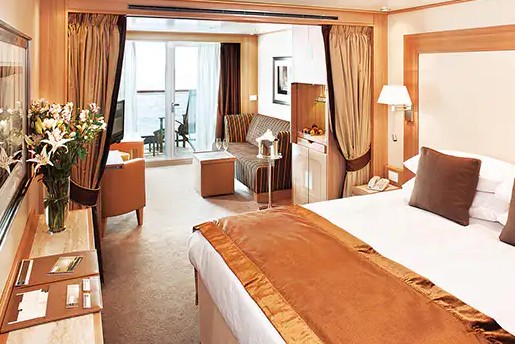Greece, Dalmatian Delights & Ephesus
Deal Details
Travel Dates
14 June 2026Sale Ends
Dec 2, 2025Priced From
$19,269 per personBonus
USD$1000 Shipboard Credit
per Suite!
Description

Sail through the heart of the Eastern Mediterranean on a luxurious 14-night voyage aboard Seabourn Quest. From the walled city of Dubrovnik to the vibrant blend of East and West in Istanbul, this journey takes you to iconic landmarks, charming islands, and hidden coastal gems.
Discover sun-drenched Croatian ports, the baroque beauty of southern Italy, the mythic landscapes of Greece, and the ancient wonders of Turkey — including Ephesus, one of the world’s best-preserved classical cities.
With access to intimate ports, award-winning service, and indulgent days at sea, this is the Mediterranean as few ever see it — effortlessly elegant, endlessly enriching.
Pricing

Ocean View Suite (Cat A)
from
$19,269*
per person, twin share

Veranda Suite (Cat V1)
from
$26,726*
per person, twin share
Itinerary
Itinerary Details
Day 0 - Dubrovnik, Croatia
Board in the “Pearl of the Adriatic,” where ancient walls encircle a city brimming with baroque charm and seaside allure.
Day 1 - Korcula
The early Greeks named this island Korkyra Melaina, or “Dark Korcula”-- because of its dense forests it loomed black on the horizon against the azure Adriatic. It is the most populous of the Dalmatian isles off the coast near Dubrovnik. Its main port is a classic medieval Dalmatian walled stone town with round towers and red-tiled roofs, perfect for strolling through narrow cobblestone byways and discovering tiny plazas where they join. In one of these, the famous traveler Marco Polo is rumored to have been born, and local people will proudly show you the very house. Another local sight you’re likely to see is the elaborately choreographed Moreska, a ritual performed by dancers with swords depicting a long-ago battle. Croatians love their coffee, and also brew wonderful beer. Enjoy one of these at an open air café, or sip the fragrant cherry liqueur called maraschino, made on the Makarska Riviera on the nearby mainland.
Day 2 - Brindisi (Leece), Italy
Set on a peninsula between two arms of the Adriatic Sea, Brindisi was an important port of the Roman Empire, and later for the East India Company. In the 2nd century BC the Appian Way was built, linking the port to Rome, and a column near the harbor marks the end of that famous route. It is here that in 71 BC, the gladiator Spartacus led thousands of rebel slaves in an unsuccessful escape. Today visitors find Romanesque churches, a 13th-century castle and, in the surrounding Apulia region, remains of ancient Messapian culture.
Day 3 - Sarande, Albania
This important port on Southern Albania curls around a superb natural harbor, dominated by the hilltop 16th century Lekuresi Castle with distinctive round towers. In the town center are the ruins of a 5th century synagogue, later a Christian basilica, with remnant mosaic floors. Another picturesque ruin is the Forty Saints Monastery from the 6th century, which is thought to have been an important pilgrimage site. But the main attraction in southern Albania is the archaeological site of Butrint, a UNESCO World Heritage Site with extensive ruins of communities dating from prehistory, though the Greek and Roman eras, as well as the Byzantine period, until the medieval period.
Day 4 - Zakinthos, Greece
The third largest of the Ionian Isles, Zakinthos is most famous for its isolated “Shipwreck Beach,” accessible only by boat. The shining white pebble beach ignites the turquoise color of the sea, as it does in the numerous small caves around Cape Skinari, again only seen from a small boat. Between Skinari and the mountain village of Keri are fantastic rock arches and other bizarre formations. The town is curved around a large harbor, and guarded by an old Venetian castle with panoramic views of the town and harbor.
Day 5 - At Sea
Day 6 - Nafplion, Greece
Held to be one of the loveliest small towns in all the islands, Nafplion has a tradition and culture all its own. The sheltered location, below a rocky headland crowned by a Venetian fortress is perhaps unrivaled in Greece. After the Greek revolution of the early 19th century, Nafplion served as the first modern capital. The neoclassical houses, large official buildings and carefully planned seafront streets all date from this period.
Day 7 - Piraeus (Athens), Greece
Piraeus has been the port for Athens since 482 BC. The busy harbor is filled with ferries and cruise ships making their way to the Greek Islands and other Mediterranean cities. The busy metropolis of Athens and its treasure trove of antiquities lie just a few miles from the port. Even as the reality of the modern city took hold, with its high-rise apartments, crowded sidewalks and bustling traffic, the beauty of the Acropolis, the outstanding museums, charming cafés, sidewalk markets and startling views come together in a cultural mosaic for all to enjoy.
Day 8 - Gythion (Sparta), Greece
Gythion, the small port town for Sparta, edges its way up the hillside, which surrounds the harbor. According to Homer, Paris and Helen spent their first night together here, on a tiny islet in the bay. To commemorate the occasion, Paris erected a shrine to Aphrodite, goddess of love, only to have it torn down by the vengeful Menelaus after he recaptured Helen. In its place Menelaus erected statues honoring Praxidica (Punishment) and Themis (Justice). Not far away, at the tip of the Peloponnese, lies the Mani, a distinctive area unlike anything else in Greece. This desolate region of underground lakes and rivers and windswept landscapes is strangely beautiful. To the north of Gythion lie Sparta and Mystra, well worth a visit.
Day 9 - Chania, Crete, Greece
Lying along the north coast of Crete is Chania, the second largest city of the island. Chania is bordered by endless stretches of seashore, with inlets and islands of exotic beauty and sandy beaches tucked away at the foot of the island's forbidding mountains. This is a self-sufficient region that is blessed with rich flora and fauna, as well as impressive gorges, holy caves, rivers and lush, green plains blanketed with citrus groves. The city of Chania is comprised of two sections, the old town and the larger modern city. Situated next to the old harbor, the old town is the focal point from which the urban area has developed. Some of the eastern and western parts of the original old Venetian fortifications from the 1500s that surrounded the town have survived and can still be seen.
Day 10 - Mykonos, Greece
The quintessential Greek island of Mykonos is marked by whitewashed houses, domed churches, imposing windmills, and a labyrinth of winding streets designed to disorient pirates. Everywhere there is a dash of bright, bold blue - doors, shutters and window frames, sea and sky. The harbor bustles with colorful fishing boats, vendors selling fish and locals gathered with visitors in the casual seaside cafes. The port even comes with two beloved mascots, the pelicans Petros and Irini.
Day 11 - Cesme, Turkey
A popular holiday and resort destination, Cesme is located on a promontory on the tip of a peninsula that carries the same name. The town itself is dominated by the medieval Cesme Castle, while the back streets invite a casual stroll with their old Ottoman and Greek houses that charm passers-by. South of the castle there is an Ottoman caravanserai built in 1528 that has since been transformed into a lovely boutique hotel, and check the Greek Orthodox church of Ayios Haralambos to see the current art exhibition. Along with the historical attractions, visitors will enjoy local pleasures, such as a dip in the thermal baths followed by the culinary delights of native fruits, artisan cheeses and local wines.
Day 12 - Kusadasi (Ephesus), Turkey
Kusadasi, which means "bird island," is set in a superb gulf known for its sparkling water, broad sandy beaches and large marina. The city has managed to retain a certain earthiness while doing a brisk trade in Turkish carpets and leather goods to visitors. The town's old quarter is a picturesque maze of winding streets and houses adorned with flowers and birdcages. In the center stands a 17th-century caravanserai, now converted into a hotel. The resort is also gateway to important sites of archaeological and religious interest.
Day 13 - At sea
Day 14 - Istanbul, Turkey
Spanning Europe and Asia, exotic Istanbul is one of the world's most fascinating cities. Domes and minarets enhance the skyline. In the old Stamboul area, traces remain of every city built since the community was established over 600 years before Christ. Once Rome's eastern capital, Istanbul was also the center of the huge Ottoman Empire. Landmarks include Hagia Sophia, once Christendom's greatest church; the Blue Mosque with its striking Iznik tiles; Topkapi Palace, containing a sultan's ransom of treasures; Chora Church with its Byzantine mosaics; and the Grand Bazaar, the ultimate shopping experience.
Top 5 Reasons to Sail Seabourn's Mediterranean

- Small-ship yacht harbors & boutique ports found off the beaten path
- Linger longer in port with itineraries curated for extended stays and overnights in marquee ports
- Hand-crafted itineraries designed for combining to explore the best of the Mediterranean
- More complimentary Signature Events: Including Marina Day, Evening at Ephesus and Shopping with the Chef*
- Seabourn’s widest array of ports offering Shopping with the Chef, with more opportunities in select ports to shop at local markets and see how the freshest ingredients are selected, with an expert Seabourn chef as your guide*
*Available on select itineraries; weather and conditions permitting.
Your Ship - Seabourn Quest
Pricing is correct as of 14 November 25 is subject to availability and change.
Cruise offer based on Black Friday Sail offer: Valid for new bookings only. Not combinable with other offers. Supplements apply for higher suite grades, categories, and fare types. Offer starts 13 November 2025 and ends 02 December 2025. Advertised fares are available until allocation is exhausted and may fluctuate. Shipboard Credit (‘Credit’) is per suite, in USD, applied to the first 2 guests in the suite only and applicable to select sailings only aligned with the More Moments on Us Event. Amount varies by suite type as specified. Oceanview and Veranda suites receive $1,000 Credit per suite, Penthouse Suites and above receive $2,000 Credit per suite. Credit expires at the conclusion of your cruise, is not transferable, not redeemable for cash and cannot be used in the casino or medical centre. Veranda Suite Upgrades are subject to availability at time of booking. Upgrade offer available from V1 to V3 and V2 to V4 categories. The higher-grade suite must be booked at the time of booking to secure the upgrade. Subject to availability. Cruise itineraries and onboard offerings are not guaranteed. Charges may apply for some activities, venues and menu items. Carnival plc trading as Seabourn ABN 23 107 998 443.